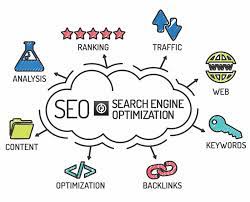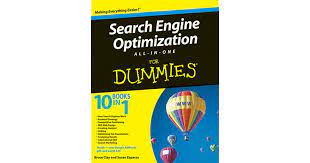Search engine optimization (SEO) is a crucial aspect of digital marketing that has become increasingly important in recent years. It refers to the process of optimizing a website’s content and structure to improve its visibility and ranking on search engine results pages (SERPs). In other words, it’s about making your website more attractive to search engines like Google, Bing, and Yahoo so they can rank it higher when people search for related terms.
Why is SEO important? Well, think about how you use search engines. When you’re looking for something online, you probably type in a few keywords or phrases related to what you’re looking for. Then, you click on one of the top results that appear on the first page of the SERP. You might not even bother scrolling down to the second or third page because you assume that the best results are already on the first page.
This is why it’s critical for businesses and website owners to invest in SEO. If your website isn’t ranking well on SERPs, then potential customers or readers won’t be able to find you easily. This means you’ll miss out on valuable traffic and potential revenue.
So what goes into SEO? There are several factors that search engines consider when ranking websites, including:
- Keywords: These are words or phrases that people use when searching for something online. By including relevant keywords in your website’s content, meta tags, and URLs, search engines can better understand what your site is about.
- Content quality: Search engines prioritize high-quality content that provides value to users. This means creating engaging blog posts, articles, videos, or other types of media that answer people’s questions or solve their problems.
- Backlinks: These are links from other websites that point back to your site. Search engines view backlinks as a sign of credibility and authority, so having high-quality backlinks can boost your site’s rankings.
- Site structure: A well-organized and easy-to-navigate site structure can improve user experience and make it easier for search engines to crawl and index your site.
- Mobile-friendliness: With more people using their mobile devices to browse the web, having a mobile-friendly website is essential. Search engines prioritize sites that are optimized for mobile devices.
There are many other factors that go into SEO, but these are some of the most important ones. SEO is an ongoing process that requires constant monitoring, tweaking, and optimization. It’s not a one-time fix, but rather a long-term investment in your website’s visibility and success.
In conclusion, SEO is an essential part of digital marketing that can help businesses and website owners improve their online visibility and attract more traffic. By optimizing your site’s content, structure, and other factors, you can increase your chances of ranking higher on SERPs and reaching more potential customers or readers. If you’re not already investing in SEO, now is the time to start!
8 Essential Tips for Effective Search Engine Optimization (SEO)
- Create unique, accurate page titles and meta descriptions for each page on your website.
- Use keyword phrases in page headings, image tags, and content to increase visibility in search engines.
- Make sure your URLs are user-friendly and descriptive of the content on the page.
- Optimize your images with descriptive file names and ALT attributes that include targeted keywords.
- Build internal links between pages on your website to help visitors explore more of your site’s content and improve indexing by search engines.
- Generate quality backlinks from other websites related to yours to increase credibility with search engines and rank higher in their results pages.
- Utilize social media platforms such as Facebook, Twitter or Instagram to promote your website’s content and draw more organic traffic from users searching for relevant topics online
- Make sure all of your webpages are indexed by submitting an XML sitemap to Google Search Console or Bing Webmaster Tools
Create unique, accurate page titles and meta descriptions for each page on your website.
When it comes to search engine optimization (SEO), creating unique and accurate page titles and meta descriptions for each page on your website is an essential tip to keep in mind. Page titles and meta descriptions are the first things that users see when they come across your website on search engine results pages (SERPs). They provide a brief summary of what your page is about and can greatly impact whether or not users click through to your site.
Creating unique and accurate page titles and meta descriptions involves using relevant keywords that accurately describe the content of each specific page on your site. This helps search engines understand what your page is about, making it easier for them to rank it appropriately.
It’s important to note that each page on your website should have its own unique title and description. This ensures that users can easily differentiate between different pages on your site and find the information they’re looking for.
In addition to improving user experience, creating unique titles and descriptions can also improve your website’s SEO. By using relevant keywords in your titles and descriptions, you can increase the likelihood of your site appearing higher up in SERPs for related searches.
Overall, creating unique and accurate page titles and meta descriptions is a simple yet effective way to improve both user experience and SEO. By taking the time to craft compelling titles and descriptions for each page on your site, you can increase the chances of attracting more traffic, boosting engagement, and ultimately achieving success online.
Use keyword phrases in page headings, image tags, and content to increase visibility in search engines.
One of the most important tips for search engine optimization (SEO) is to use keyword phrases in page headings, image tags, and content. This is because search engines use these elements to determine what your website is about and how relevant it is to a user’s search query.
Page headings, also known as H1 tags, are the main titles that appear on a webpage. Including your target keyword phrase in the H1 tag can signal to search engines that your page is relevant to that topic.
Image tags, or alt tags, are descriptions of images on your website. By including your target keyword phrase in the alt tag, you can help search engines understand what the image is about and improve its visibility in image searches.
Finally, incorporating your target keyword phrase throughout your content can help search engines understand what your page is about and increase its relevance for related searches.
However, it’s important to use keywords naturally and not overstuff them into your content. Your primary focus should always be creating high-quality content that provides value to users.
By using keyword phrases strategically in page headings, image tags, and content, you can improve your website’s visibility in search engines and attract more traffic from relevant searches.
Make sure your URLs are user-friendly and descriptive of the content on the page.
When it comes to search engine optimization (SEO), every little detail counts. One important tip that many website owners overlook is the importance of user-friendly and descriptive URLs.
URLs, or uniform resource locators, are the addresses that users type into their web browsers to access specific pages on your website. Search engines also use URLs to understand what your content is about and determine how relevant it is to specific search queries.
To ensure that your URLs are user-friendly and descriptive, it’s important to follow a few best practices. First, make sure that your URLs are short and easy to read. Avoid using long strings of numbers or characters that don’t provide any meaningful information about the content on the page.
Secondly, include relevant keywords in your URLs. This helps search engines understand what the page is about and can improve its visibility in search results. For example, if you have a blog post about “The Best Restaurants in New York City,” your URL should be something like “yourdomain.com/best-restaurants-new-york-city” rather than “yourdomain.com/post12345”.
Finally, make sure that your URLs accurately reflect the content on the page. Don’t use misleading or generic URLs that don’t provide any indication of what users can expect to find on the page.
By following these simple tips for user-friendly and descriptive URLs, you can improve your website’s SEO and help users find exactly what they’re looking for on your site.
Optimize your images with descriptive file names and ALT attributes that include targeted keywords.
When it comes to search engine optimization (SEO), many people focus solely on optimizing their website’s text content. However, images can also play a significant role in improving your site’s visibility and rankings on search engine results pages (SERPs).
One way to optimize your images for SEO is by using descriptive file names and ALT attributes that include targeted keywords. This means naming your image files in a way that accurately describes the image and includes relevant keywords, and adding ALT attributes that provide additional information about the image using those same keywords.
Why is this important? Well, search engines can’t “see” images in the same way humans can. They rely on text descriptions like file names and ALT attributes to understand what an image is about. By using descriptive file names and ALT attributes with targeted keywords, you’re making it easier for search engines to understand your images and associate them with relevant content.
For example, let’s say you have an image of a red dress on your website. Instead of naming the file “IMG_1234.jpg,” you could name it “red-dress.jpg.” Then, in the ALT attribute, you could add more details like “Red dress with spaghetti straps by XYZ brand.” By including targeted keywords like “red dress” and “spaghetti straps,” you’re making it more likely that your image will appear in relevant search results.
Overall, optimizing your images with descriptive file names and ALT attributes is a simple yet effective way to improve your website’s SEO. It helps search engines better understand your content and can lead to increased visibility and traffic over time. So next time you upload an image to your website, take a few extra minutes to give it a descriptive name and add an informative ALT attribute – it could make all the difference!
Build internal links between pages on your website to help visitors explore more of your site’s content and improve indexing by search engines.
Internal linking is an often-overlooked aspect of search engine optimization (SEO), but it can play a significant role in improving your website’s visibility and user experience. By building internal links between pages on your site, you can help visitors explore more of your content and encourage them to stay on your site longer.
Internal links are hyperlinks that point to other pages on the same website. For example, if you have a blog post about “5 Tips for Healthy Eating,” you might include a link to another post about “The Benefits of Exercise.” This not only helps visitors discover more relevant content on your site but also shows search engines that your site is well-organized and has valuable content.
Internal linking can also improve indexing by search engines. When search engine crawlers visit your site, they follow links to discover new pages and index them in their database. By providing clear and relevant internal links, you can help search engines understand the structure and hierarchy of your site’s content.
To make the most of internal linking, consider the following tips:
- Use descriptive anchor text: The anchor text is the clickable text that appears in a hyperlink. Make sure it accurately describes where the link is going so visitors know what to expect.
- Link to relevant pages: Internal links should be helpful and relevant to the reader’s interests. Don’t force links where they don’t fit naturally.
- Use a logical hierarchy: Organize your internal links in a way that makes sense for both visitors and search engines. For example, if you have a page about “Healthy Eating,” link to related subtopics like “Meal Planning” or “Recipe Ideas.”
In conclusion, building internal links between pages on your website can have numerous benefits for both users and search engines. By making it easy for visitors to explore more of your content, you can keep them engaged and encourage them to return in the future. At the same time, providing clear and relevant internal links can improve indexing by search engines, helping your site rank higher on search engine results pages.
Generate quality backlinks from other websites related to yours to increase credibility with search engines and rank higher in their results pages.
Generating quality backlinks from other websites related to yours is a highly effective tip for improving your website’s search engine optimization (SEO). Backlinks are essentially links from other websites that point back to your site. Search engines view these links as a sign of credibility and authority, so having high-quality backlinks can boost your site’s rankings.
However, it’s important to note that not all backlinks are created equal. The quality of the backlinks matters more than the quantity. In other words, having a few high-quality backlinks from authoritative sites is better than having many low-quality backlinks from spammy sites.
To generate quality backlinks, start by reaching out to other websites in your niche or industry. Offer to write guest posts or contribute content in exchange for a link back to your site. You can also create valuable content on your own site that others will want to link to naturally.
It’s also important to monitor your existing backlinks and disavow any low-quality or spammy links that could hurt your site’s credibility with search engines. Regularly auditing and optimizing your backlink profile is an essential part of SEO.
In conclusion, generating quality backlinks from related websites is a powerful way to improve your website’s SEO and increase its credibility with search engines. By focusing on building high-quality links rather than just quantity, you can boost your site’s rankings and attract more traffic over time.
Utilize social media platforms such as Facebook, Twitter or Instagram to promote your website’s content and draw more organic traffic from users searching for relevant topics online
Social media platforms such as Facebook, Twitter, and Instagram have become powerful tools for businesses and website owners to promote their content and attract more organic traffic from users searching for relevant topics online. By utilizing these platforms, you can reach a wider audience and increase your website’s visibility on search engine results pages (SERPs).
When you share your website’s content on social media, you’re not only promoting it to your followers but also potentially reaching their followers as well. This means that your content has the potential to go viral and reach a much larger audience than it would have otherwise.
In addition to promoting your content, social media can also help build brand awareness and credibility. By engaging with your followers and responding to their comments or questions, you can establish a relationship of trust with them. This can lead to more shares, likes, and ultimately more traffic to your website.
To maximize the benefits of social media for SEO, it’s important to optimize your profiles by including relevant keywords in your bio, description, and posts. You should also make sure that your profiles are linked back to your website so that users can easily find more information about you.
In conclusion, social media is a powerful tool that can help businesses and website owners promote their content and attract more organic traffic from users searching for relevant topics online. By utilizing these platforms effectively, you can increase your website’s visibility on SERPs and establish a relationship of trust with your followers. So don’t wait any longer – start leveraging the power of social media today!
Make sure all of your webpages are indexed by submitting an XML sitemap to Google Search Console or Bing Webmaster Tools
Submitting an XML sitemap to Google Search Console or Bing Webmaster Tools is a crucial step in ensuring that all of your website’s pages are indexed and easily found by search engines. An XML sitemap is a file that lists all of the pages on your site, along with important information about each page, such as its URL, when it was last updated, and how frequently it changes.
By submitting an XML sitemap to search engine tools like Google Search Console or Bing Webmaster Tools, you’re essentially telling those search engines which pages on your site are important and should be crawled and indexed. This can help improve your site’s visibility and rankings on search engine results pages (SERPs), as well as make it easier for users to find the information they’re looking for.
Submitting an XML sitemap is a relatively simple process. First, you’ll need to create an XML sitemap file using a tool like Yoast SEO or Google’s own XML Sitemap Generator. Once you have the file, you can submit it to Google Search Console or Bing Webmaster Tools by following their respective submission processes.
It’s important to note that submitting an XML sitemap doesn’t guarantee that all of your site’s pages will be indexed by search engines. However, it does increase the likelihood that they will be crawled and indexed more quickly and efficiently than if you didn’t submit a sitemap at all.
In conclusion, submitting an XML sitemap to Google Search Console or Bing Webmaster Tools is a simple but crucial step in optimizing your website for search engines. By ensuring that all of your site’s pages are easily found and indexed, you can improve your site’s visibility and rankings on SERPs, ultimately driving more traffic to your site.




